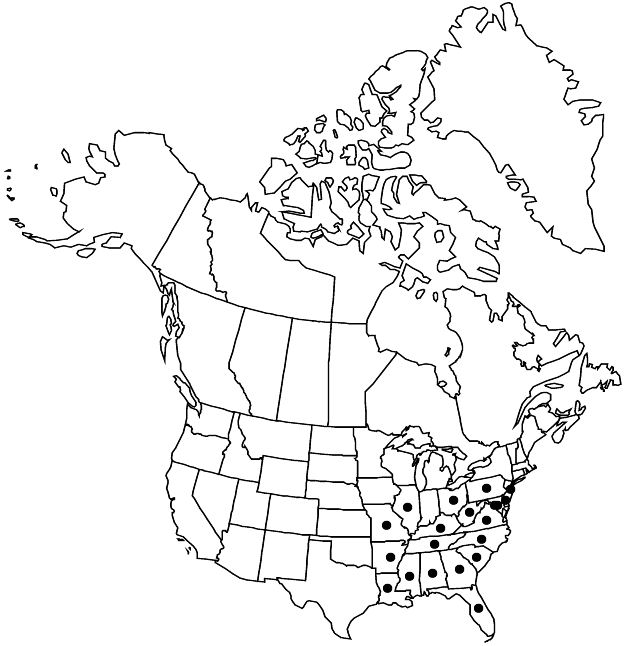Difference between revisions of "Malus angustifolia"
Fl. Bor.-Amer. 1: 292. 1803.
FNA>Volume Importer |
imported>Volume Importer |
||
| (3 intermediate revisions by 2 users not shown) | |||
| Line 15: | Line 15: | ||
|name=Pyrus angustifolia | |name=Pyrus angustifolia | ||
|authority=Aiton | |authority=Aiton | ||
| + | |rank=species | ||
|publication_title=Hort. Kew. | |publication_title=Hort. Kew. | ||
|publication_place=2: 176. 1789 | |publication_place=2: 176. 1789 | ||
| Line 21: | Line 22: | ||
|name=Malus coronaria var. angustifolia | |name=Malus coronaria var. angustifolia | ||
|authority=(Aiton) Ponomarenko | |authority=(Aiton) Ponomarenko | ||
| + | |rank=variety | ||
}} {{Treatment/ID/Synonym | }} {{Treatment/ID/Synonym | ||
|name=P. coronaria var. angustifolia | |name=P. coronaria var. angustifolia | ||
|authority=(Aiton) Wenzig | |authority=(Aiton) Wenzig | ||
| + | |rank=variety | ||
}} | }} | ||
|hierarchy=Rosaceae;Rosaceae subfam. Amygdaloideae;Rosaceae tribe Gillenieae;Malus;Malus angustifolia | |hierarchy=Rosaceae;Rosaceae subfam. Amygdaloideae;Rosaceae tribe Gillenieae;Malus;Malus angustifolia | ||
| Line 48: | Line 51: | ||
-->{{#Taxon: | -->{{#Taxon: | ||
name=Malus angustifolia | name=Malus angustifolia | ||
| − | |||
|authority=(Aiton) Michaux | |authority=(Aiton) Michaux | ||
|rank=species | |rank=species | ||
| Line 63: | Line 65: | ||
|publication year=1803 | |publication year=1803 | ||
|special status=Endemic | |special status=Endemic | ||
| − | |source xml=https:// | + | |source xml=https://bitbucket.org/aafc-mbb/fna-data-curation/src/2e0870ddd59836b60bcf96646a41e87ea5a5943a/coarse_grained_fna_xml/V9/V9_800.xml |
|subfamily=Rosaceae subfam. Amygdaloideae | |subfamily=Rosaceae subfam. Amygdaloideae | ||
|tribe=Rosaceae tribe Gillenieae | |tribe=Rosaceae tribe Gillenieae | ||
Latest revision as of 22:59, 5 November 2020
Trees, sometimes shrubs, 10–50(–100) dm. Stems 5–25 cm diam.; bark reddish brown to gray, longitudinally fissured with platelike scales; young branches reddish brown, sparsely puberulent, becoming gray or grayish brown, glabrescent; flowering shoots developing as short spurs or spiny thorns, (5–)10–40(–60) mm. Buds reddish brown, ovoid, 1.6 mm, scale margins tomentose. Leaves conduplicate in bud; heteromorphic; stipules deciduous, linear-lanceolate, 2–4(–5) mm, apex acuminate; vigorous shoot leaves: petiole (10–)15–25 mm, villous, sometimes tomentose; blade elliptic, oval, or ovate, sometimes triangular-ovate, (3.5–)4–6(–8) × (1.5–)3–4(–5) cm, base cuneate, sometimes rounded, margins sometimes slightly lobed, crenate, crenate-serrate, serrate, or entire, sometimes doubly serrate, apex rounded, broadly acute, sometimes apiculate, abaxial surface glabrous (villous only on veins), adaxial glabrous; flowering shoot leaves: petiole 3–10(–25) mm, villous, sometimes glabrous; blade elliptic or oblong, sometimes ovate, obovate, or lanceolate, (9–)15–50(–65) × (7–)10–20(–30) mm, base cuneate, sometimes rounded, margins unlobed, crenate, crenate-serrate, or entire, apex rounded (with point or acute), abaxial surface glabrous (veins villous), adaxial glabrous. Panicles corymblike; peduncles absent; bracteoles sometimes persistent, filiform, (1–)3–4(–6) mm. Pedicels (10–)20–30(–40) mm, glabrous, sometimes slightly villous. Flowers 20–30 mm diam.; hypanthium glabrous, rarely slightly villous; sepals triangular, (2–)3–4(–5) mm, equal to tube, apex acuminate, abaxial surface glabrous, adaxial hoary-tomentose; petals pink, sometimes fading white, oblong to narrowly obovate, (10–)12–16(–22) mm, claws (2–)3 mm, margins entire, sinuate, or fimbriate, apex rounded; stamens 20, (7–)9–12(–14) mm, anthers pink or rose before dehiscence; styles 5, connate basally, (6–)9–12(–15) mm, usually slightly longer than stamens, tomentose in proximal 1/3. Pomes green or yellow-green, subglobose, 10–20(–30) mm diam., cores not enclosed at apex; sepals persistent, erect; sclereids abundant surrounding core. Seeds dark brown. 2n = 34 (68).
Phenology: Flowering (Feb–)Mar–May; fruiting Aug–Sep.
Habitat: Open woods, thickets, hillsides, stream and lake banks, flood plains, terraces, roadsides, open fields, sandy soil, clay soil
Elevation: 10–700 m
Distribution

Ala., Ark., Del., D.C., Fla., Ga., Ill., Ky., La., Md., Miss., Mo., N.J., N.C., Ohio, Pa., S.C., Tenn., Va., W.Va.
Discussion
The attractive flowers of Malus angustifolia have a pleasant, violetlike odor.
Selected References
None.